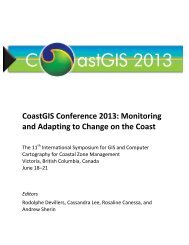in Context the SCotian Shelf - COINAtlantic
in Context the SCotian Shelf - COINAtlantic
in Context the SCotian Shelf - COINAtlantic
Create successful ePaper yourself
Turn your PDF publications into a flip-book with our unique Google optimized e-Paper software.
Benthic Organisms<br />
Benthic <strong>in</strong>vertebrate species <strong>in</strong>clude species that<br />
live with<strong>in</strong> <strong>the</strong> bottom substrates (<strong>in</strong>faunal) and on<br />
<strong>the</strong> seafloor (epifaunal). Generally more is known<br />
about species that are found on <strong>the</strong> seafloor.<br />
Invertebrates: Infauanal and non-commercial<br />
The non-commercial benthic <strong>in</strong>vertebrate species<br />
found <strong>in</strong> Nova Scotia’s waters represent many<br />
billions of animals, stretch<strong>in</strong>g from <strong>the</strong> shallow<br />
<strong>in</strong>tertidal organisms to deep water abyssal species<br />
(Breeze et al. 2002). Most of <strong>the</strong>se species<br />
are not well studied and not well described<br />
beyond <strong>the</strong> <strong>in</strong>tertidal zone (Breeze et al. 2002).<br />
As mentioned previously work is underway to<br />
classify benthic communities of <strong>the</strong> Scotian <strong>Shelf</strong>.<br />
Examples of <strong>in</strong>fuanal non-commercial <strong>in</strong>vertebrates<br />
found on <strong>the</strong> Scotian <strong>Shelf</strong> <strong>in</strong>clued various<br />
polycheate worms. Epifaunal organisms <strong>in</strong>clude<br />
certa<strong>in</strong> ech<strong>in</strong>oderms (starfish and sand dollars),<br />
anemones, corals, sponges and tunicates. Research<br />
is <strong>in</strong>creas<strong>in</strong>g on corals and sponges on <strong>the</strong><br />
Scotian <strong>Shelf</strong>.<br />
Cold-water corals are suspension-feed<strong>in</strong>g<br />
<strong>in</strong>vertebrates with fea<strong>the</strong>ry tentacles that capture<br />
food particles from <strong>the</strong> water column. Unlike<br />
<strong>the</strong>ir tropical counterparts, cold-water corals do<br />
not have symbiotic algae and can live far below<br />
<strong>the</strong> reach of sunlight. Many corals require a hard<br />
substrate for attachment; however some species<br />
can anchor <strong>in</strong> soft sediments. Corals can occur <strong>in</strong><br />
many shapes, sizes and forms and some species<br />
can form reefs. They are slow grow<strong>in</strong>g and some<br />
may be over 100 years old. On <strong>the</strong> Scotian <strong>Shelf</strong>,<br />
corals are concentrated <strong>in</strong> areas with high current<br />
activity (Breeze et al. 1997, Mortensen et al.<br />
2006). Corals represent a varied habitat for o<strong>the</strong>r<br />
organisms, such as fish, shrimp and sea stars.<br />
They offer shelter from predators, a nursery area<br />
for juveniles, and attachment substrate for o<strong>the</strong>r<br />
organisms (DFO 2010b).<br />
Around 25 to 30 species of corals have been<br />
identified off <strong>the</strong> Atlantic Coast of Nova Scotia.<br />
They can be organized <strong>in</strong> two major groups, hard<br />
or stony corals (Scleract<strong>in</strong>ia) and octocorals. Both<br />
solitary and colonial (reef-build<strong>in</strong>g) forms of corals<br />
are found along <strong>the</strong> slope of <strong>the</strong> Scotian <strong>Shelf</strong><br />
(DFO 2006). A live colony of <strong>the</strong> reef-build<strong>in</strong>g<br />
coral, Lophelia pertusa, has been found at <strong>the</strong><br />
mouth of <strong>the</strong> Laurentian Channel on <strong>the</strong> Scotian<br />
<strong>Shelf</strong>. The solitary cup corals are widespread<br />
<strong>in</strong> soft sediments along <strong>the</strong> Slope and are also<br />
found <strong>in</strong> bas<strong>in</strong>s of <strong>the</strong> Scotian <strong>Shelf</strong>.<br />
Octocorals <strong>in</strong>clude sea pens, sea whips, sea fans<br />
and “soft corals.” The largest octocorals on <strong>the</strong><br />
Scotian <strong>Shelf</strong> are <strong>the</strong> gorgonian corals: bubblegum<br />
and seacorn corals. These corals prefer habitats<br />
of hard sea bottom and attach <strong>the</strong>mselves<br />
to large rocks and boulders. They have only been<br />
found <strong>in</strong> <strong>the</strong> channels between <strong>the</strong> banks and <strong>in</strong><br />
<strong>the</strong> canyons. Sea pens and small gorgonians are<br />
found on soft sediments and are able to anchor<br />
to <strong>the</strong>m. A relatively high concentration of sea<br />
pens has been identified near Middle Bank on<br />
<strong>the</strong> Scotian <strong>Shelf</strong> (Kench<strong>in</strong>gton et al. 2010).<br />
Sponges are mar<strong>in</strong>e <strong>in</strong>vertebrates that attach<br />
<strong>the</strong>mselves to bottom substrates. Sponges are<br />
filter feeders and are generally found at depth<br />
below 300 m. Sponges can provide substrate and<br />
offer shelter for o<strong>the</strong>r organisms (DFO 2010b). A<br />
unique and significant population of Russian Hat<br />
http://co<strong>in</strong>atlantic.ca/<strong>in</strong>dex.php/state-of-<strong>the</strong>-scotian-shelf<br />
19













